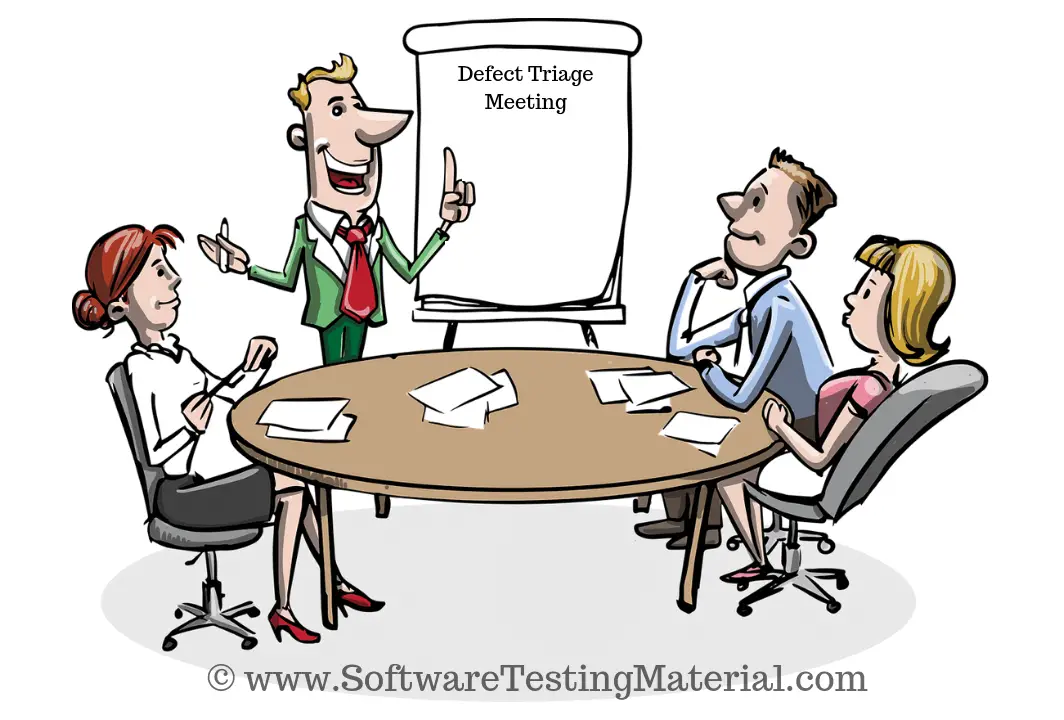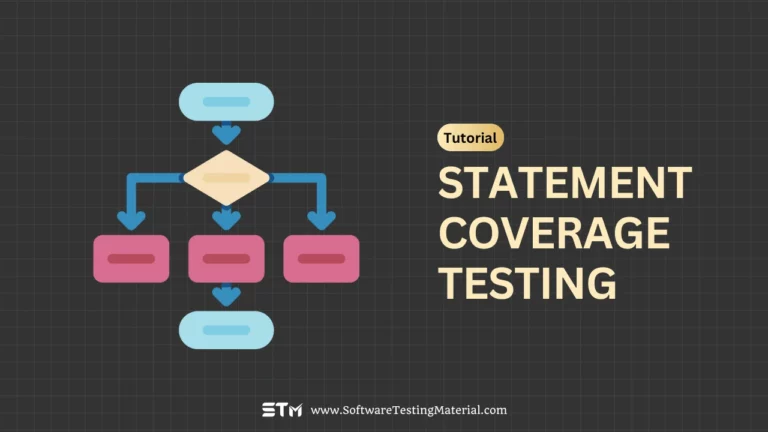Defect Triage in Software Testing | Bug Triage Guide
In this article, we bring complete details on What is Defect Triage (Bug Triage), Defect Triage Meeting Process, and How to handle Defect Triage Meetings.

What is Defect Triage in Software Testing?
Defect Triage is also known as Bug Triage.
Don’t get confused with the terms Bug and Defect. You check the difference between Defect, Bug, Error & Failure here.
The term Triage is used in Software Testing to define the severity and priority of defects. Defect triage is a process or mechanism where each defect is prioritized based on its severity, risk, reoccurrence, etc.,
Triage is a medical word. Triage is the process of quickly examining patients who are taken to a hospital in order to decide which ones are the most seriously ill and must be treated first. Patients will be categorized based on the severity of the illness and then the doctors treat the patients who are seriously ill on a priority basis. Patients who have non-critical diseases are considered as low priority patients and were treated after the patients who are seriously ill.
In Software Testing, we use the word Triage with the combination of Bug/Defect like Bug Triage or Defect Triage. Here we apply the same concept to bugs found during the testing phase. It is to decide the priority of the bugs based on their severity, risk, and frequency of reoccurrence, etc.,
Also, you can check the Defect Life Cycle and How To Write A Good Bug Report.
Why do You Need Defect Triaging?
Defect triaging ensures that testing teams efficiently manage and resolve software defects. Testing teams prioritize defects based on their impact and severity, allowing them to focus on the most critical issues that could affect user experience or system functionality.
By organizing and categorizing defects, teams allocate resources effectively and streamline the development process. This approach not only saves time but also enhances communication among team members, ensuring everyone understands what needs to be fixed first. Ultimately, defect triaging allows teams to deliver high-quality software on time.
What is Defect Triage Meeting?

Bug Triage Meeting is done to sort out the priority of all open bugs. When and how these open bugs need to be fixed is decided in this Defect Triage Meeting.
The objective of a triage meeting is to track all the defects and makes sure the correct resolution in a timely manner.
During Defect Triage Meetings, Triage Teams decide how to categorize and prioritize defects. Categories often used are
- We are going to fix this now
- We are going to fix this later
- We are never going to fix this
Defect Triage comes into the picture in Software Testing when there are no sufficient resources to handle the defects. Imagine a situation where there are a number of defects are more and the resources to handle those are limited. In this case, defect triage helps to get as many defects resolved as possible by assessing the defects and prioritize them based on the severity of the defects.
The frequency of the Software Bug Triage meeting is weekly, monthly, on each sprint (defect triage in Agile). It varies from project to project.
What is the process of the Defect Triage Meeting?
The defect triage process is as follows:
- Defect Review
- Defect Assessment
- Defect Assignment

The triage team reviews the defects to fix the defects. Defect assessment will be done on the basis of defect severity. In this assessment process, the triage team will decide whether these defects are needed to be fixed or kept on hold, or removed from the list. The defects which are in the list of ‘to be fixed’ will be assigned to the concerned department/person after proper analysis of the defects.
What are the questions raised during the Defect Triage Meeting?
Questions raised during the Defect Triage Meeting are as follows:
- Is this bug valid?
- What is the severity of the bug?
- When to fix this bug?
These questions will be applied to each and every defect in the list of all open bugs.
What is the purpose of having a Defect Triage Meeting?
The purpose of defect triage meeting in the Software Development Process is to prioritize the defects based on their severity, risk, reoccurrence, etc., Team involved in Defect Triage Meeting should have a proper defect triage meeting agenda and validate severities of the defect, make changes as required, finalize resolution of the defects, and assign resources to fix it.
Who are the participants in the Defect Triage Meeting?
Test Lead, Development Lead, and Project Manager are the main participants in the Defect Triage Meeting as these people will discuss all the defects and take necessary action. It’s more like having one person from each department. The test lead is the one who has knowledge of the bug which was recorded. The development lead is the one who can give an idea on how to fix the bug and also can explain technical hurdles if any. The Project Manager is the one who has a better understanding of whether or not the bug is actually a bug or if it’s a feature request.
Participants in the Defect Triage Meeting are as follows:
- Test Lead
- Development Team Lead
- Project Manager
- Test Manager
- Product Manager
- Testers
- Developers
- Business Analyst
There is no rule like everyone should involve in this meeting. It varies from company to company. Mandatory participants are Project Manager, Test Lead, and Development Lead. Test Lead or Project Manager invites other members whenever necessary to get feedback regarding specific bugs. This entire team is known as Triage Team.
What are the Roles and Responsibilities of the Triage Team during the Defect Triage Meeting?
1. Test Lead
- Test Lead schedules a defect triage meeting and sends out a formal meeting invite along with the defect report to the Triage Team
- Assigns priority and severity of the defects
- Gives presentation on each defect so that each triage team member understand the root cause of defects
- Makes a minutes of meeting and shares with the Triage Team after the meeting
2. Project Manager
- Involves in assisting the team in the process of prioritizing the defects
- Involves in tracking the issues list
- Involves in gathering the confirmation from Dev Team for the next release date for QA
- Ensures that whether all the participants from every team is available for the meeting
- Acts as a mediator and takes necessary decisions, if any dispute or conflict occurs between the teams
3. Development Team Lead
- Helps in the process of prioritizing the defects
- Explains the defect complexity and risk involved in fixing the defect to the participants
- Allocate work to appropriate developers to get the defects fixed
What are the activities carried out in the Defect Triage meeting?
I have worked on an ERP project. The size of the product is huge and the frequency of reporting bugs is high. Due to the high volume, our Project Manager used to call for a Defect Triage meeting every two weeks once.
Once the Project Manager or Test Lead decides to setup a Triage Meeting then Test Lead invites Triage Team to the meeting. Test Lead conveys a bug report with the new defects presented since the last gathering. The reason behind sharing bug reports is to get an idea of each bug before joining the meeting.
The activities carried out in the bug triage meeting are as follows:
Pre-meeting
All the participants should understand the bugs, so testers should take responsibility in the following points
- To provide enough information in the bug description
- Posting the bugs under an appropriate category
- To verify the severity and priority which was assigned to each bug
During the meeting
- Once the meeting kickstarts, participants in the meeting discuss the previous triage meeting’s pending issues.
- Then they move on to the report which was circulated by Test Lead to review and evaluate. In this process, defect description or Severity and Priority of the defect will be updated, if something is inappropriate.
- Triage Team in the meeting look into the issues and come to a conclusion on which defects should require immediate attention and which defects can be postponed for future releases.
i. In the initial stage of the project, even the lowest priority bugs will be accepted to fix
it. When the deadline is reaching, teams will concentrate more on high priority bugs and keep others on hold - Based on the above two points, the status of the bugs will be updated and assigned to the respective teams
- Finally, Test Lead calls out for the meeting after taking a note of all the action items.
Post Meeting
After the triage meeting, the Test lead shares the MOM (Minutes of the meeting) with the Triage Team.
Download Sample Defect Triage Report
Click the below download button to download the Sample Defect Triage Report.
Bug Triage Report Format
As I mentioned earlier, before every triage meeting, Test lead shares defect report to all the participants. Here is a sample format.

Fields involved in this report are as follows:
- Defect Id: Defect Identifier is a unique number to identify the defect
- Defect Description: Description of the defect
- Created On: Date on which the defect was initially reported
- Created By: Name of the person who reported the defect
- Severity: Severity of the defect – how it affects the system
- Priority: The priority code indicates the impact of this defect on the project:
High – Extremely important, the project cannot be successful without this defect being resolved
Medium – Important to project success, but a work around exists
Low – Desirable, but with little impact to project success if the defect is not resolved - Status: Current status of the defect (New, In Progress, Under Review and Completed)
- Assigned Date: Date on which the defect was assigned for resolution
- Assigned To: Name of the person who is responsible for fixing the defect
- Resolution: Description of the defect’s resolution
- Resolution Date: Date on which the defect is to be resolved
- Estimated Time To Fix: Estimated amount of time required to fix the defect
- Actual Time to Fix: Actual time taken to fix the defect
- Root Cause Description: State the cause of the defect
Challenges in Defect Triaging
- Effective Communication: Ensuring everyone on the team understands the priorities can be tough, and miscommunications can lead to mistakes in setting bug priorities.
- Impact Assessment: It can be challenging to judge how a defect affects the project. This requires a deep understanding of the software and how it is used.
- Managing Volume: With so many defects, it can be hard to know where to focus limited resources and time.
- Changing Requirements: As project needs evolve, priorities can change too, making the triage process more complicated.
- Consistent Process: Keeping a consistent and clear process for managing defects helps in addressing these challenges effectively.
Conclusion
Bug triage meeting is an effective approach to manage and fix defects throughout the testing life cycle. The frequency of the Defect Triage should be weekly, monthly, every sprint (in Agile).
If you have any queries on Defect Triage, Defect Triage Process and Defect Triage Meeting, please comment below.
You may also like these posts:
- Earn Money By Testing Websites – UserTesting Review
- How to write a mind-blowing Bug Report
- Smoke Testing vs Sanity Testing
- Test Cases vs Test Scenarios
- Integration Testing – Complete Guide
- API Testing – Detailed Guide






